engine MITSUBISHI ECLIPSE CROSS 2018 Owner's Manual (in English)
[x] Cancel search | Manufacturer: MITSUBISHI, Model Year: 2018, Model line: ECLIPSE CROSS, Model: MITSUBISHI ECLIPSE CROSS 2018Pages: 417, PDF Size: 74.06 MB
Page 380 of 417

Fusible links
Vehicle care and maintenance 9-23
9
snow off the vehicle and a plastic scraper for the windshield, rear window, and side win- dows are also useful.
N00942700291
The fusible links will melt
to prevent a fire if
a large current attempts to flow through cer- tain electrical systems.In case of a melted fusible link, see yourauthorized Mitsubishi Motors dealer or a repair facility of your choice for inspection and replacement.For the fusible links, please refer to “Fuse load capacities” on page 9-23.
N00942801967
To prevent damage to the electrical system from short-circuiting or overloading, each
individual circuit is equipped with a fuse. The fuse blocks are located in the passenger com- partment and in the engine compartment. The fuse block in the passenger compartment is located behind the fuse lid in front of the driver’s seat at the position shown in the illus-tration.Pull the fuse lid to remove it. The fuse block in the engine compartment is located as shown in the illustration.Press the lock lever (1) and remove the fuse block cover (2).
N00954801443
This fuse list shows the names of the electri- cal systems and their fuse capacities. There are spare fuses in the fuse block cover in the engine compartment. Always replace ablown fuse with one of the same capacity asthe original.
Fusible links
WA R N I N G Fusible links must not be replaced by any other device. Failing to fit the correct fus-ible link may result in fire in the vehicle, property destruction and serious or fatal injuries at any time.
Fuses Fuse block location
Passenger compartment A- Fuse blockEngine compartment
Fuse load capacities
BK0252700US.bo
ok 23 ページ 2017年10月4日 水曜日 午後4時54分
Page 381 of 417
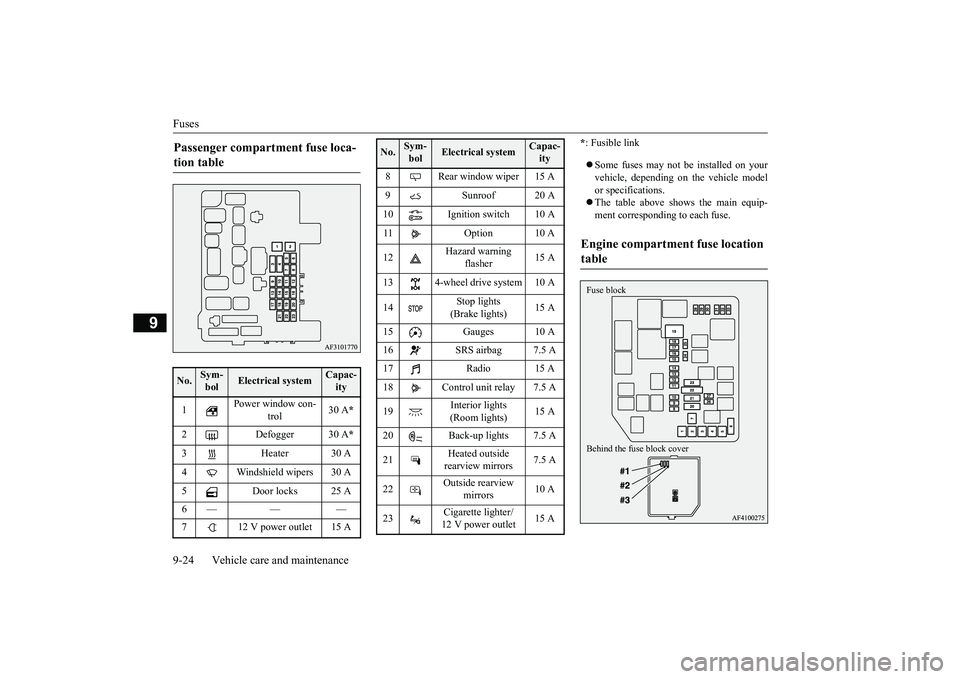
Fuses 9-24 Vehicle care and maintenance
9
* : Fusible link Some fuses may not be installed on your vehicle, depending on the vehicle model or specifications. The table above shows the main equip- ment corresponding to each fuse.
Passenger compartment fuse loca- tion table No.
Sym- bol
Electrical system
Capac-ity
1
Power window con-
trol
30 A
*
2 Defogger 30 A
*
3 Heater 30 A 4 Windshield wipers 30 A 5 Door locks 25 A 6— — — 7 12 V power outlet 15 A
8 Rear window wiper 15 A 9 Sunroof 20 A 10 Ignition switch 10 A 11 Option 10 A 12
Hazard warning
flasher
15 A
13 4-wheel drive system 10 A14
Stop lights (Brake lights)
15 A
15 Gauges 10 A 16 SRS airbag 7.5 A 17 Radio 15 A 18 Control unit relay 7.5 A 19
Interior lights (Room lights)
15 A
20 Back-up lights 7.5 A21
Heated outside rearview mirrors
7.5 A
22
Outside rearview
mirrors
10 A
23
Cigarette lighter/ 12 V power outlet
15 A
No.
Sym- bol
Electrical system
Capac-ity
Engine compartment fuse location table Behind the fuse block cover Fuse block
BK0252700US.bo
ok 24 ページ 2017年10月4日 水曜日 午後4時54分
Page 382 of 417
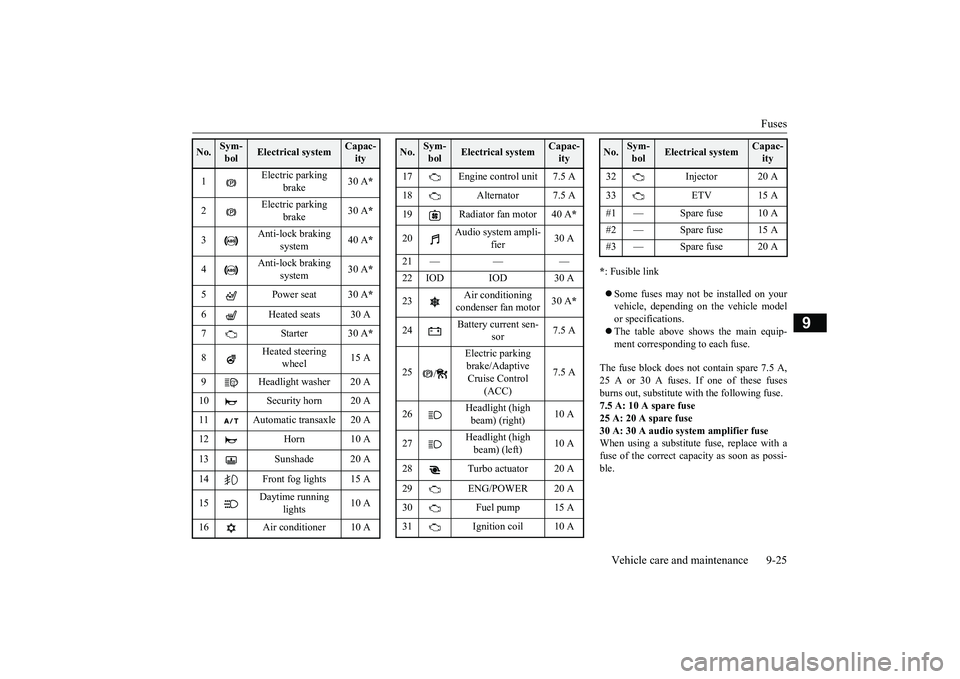
Fuses
Vehicle care and maintenance 9-25
9
* : Fusible link Some fuses may not be installed on your vehicle, depending on the vehicle model or specifications. The table above shows the main equip- ment corresponding to each fuse.
The fuse block does not contain spare 7.5 A, 25 A or 30 A fuses. If one of these fusesburns out, substitute with the following fuse.7.5 A: 10 A spare fuse 25 A: 20 A spare fuse 30 A: 30 A audio system amplifier fuseWhen using a substitute fuse, replace with a fuse of the correct capacity as soon as possi- ble.
No.
Sym- bol
Electrical system
Capac-ity
1
Electric parking
brake
30 A
*
2
Electric parking
brake
30 A
*
3
Anti-lock braking
system
40 A
*
4
Anti-lock braking
system
30 A
*
5 Power seat 30 A
*
6 Heated seats 30 A 7Starter30 A
*
8
Heated steering
wheel
15 A
9 Headlight washer 20 A 10 Security horn 20 A 11 Automatic transaxle 20 A 12 Horn 10 A 13 Sunshade 20 A14 Front fog lights 15 A 15
Daytime running
lights
10 A
16 Air conditioner 10 A
17 Engine control unit 7.5 A 18 Alternator 7.5 A 19 Radiator fan motor 40 A
*
20
Audio system ampli-
fier
30 A
21 — — — 22 IOD IOD 30 A 23
Air conditioning condenser fan motor
30 A
*
24
Battery current sen-
sor
7.5 A
25
/
Electric parking brake/Adaptive Cruise Control
(ACC)
7.5 A
26
Headlight (high beam) (right)
10 A
27
Headlight (high beam) (left)
10 A
28 Turbo actuator 20 A 29 ENG/POWER 20 A 30 Fuel pump 15 A31 Ignition coil 10 ANo.
Sym- bol
Electrical system
Capac-ity
32 Injector 20 A 33 ETV 15 A #1 — Spare fuse 10 A #2 — Spare fuse 15 A#3 — Spare fuse 20 ANo.
Sym- bol
Electrical system
Capac-ity
BK0252700US.bo
ok 25 ページ 2017年10月4日 水曜日 午後4時54分
Page 383 of 417
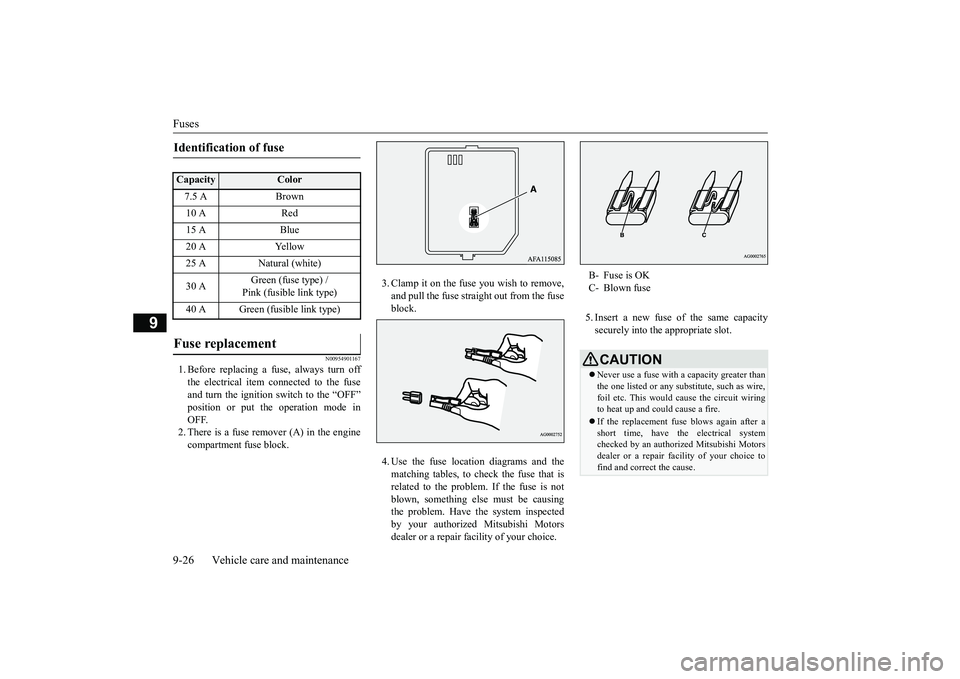
Fuses 9-26 Vehicle care and maintenance
9
N00954901167
1. Before replacing a fuse, always turn off the electrical item connected to the fuse and turn the ignition switch to the “OFF”position or put the operation mode in OFF. 2. There is a fuse remover (A) in the enginecompartment fuse block.
3. Clamp it on the fuse you wish to remove, and pull the fuse straight out from the fuseblock. 4. Use the fuse location diagrams and the matching tables, to check the fuse that is related to the problem. If the fuse is not blown, something else must be causingthe problem. Have the system inspectedby your authorized Mitsubishi Motors dealer or a repair facility of your choice.
5. Insert a new fuse of the same capacity securely into the appropriate slot.
Identification of fuse Capacity
Color
7.5 A Brown10 A Red15 A Blue20 A Yellow25 A Natural (white) 30 A
Green (fuse type) / Pink (fusible link type)
40 A Green (fusible link type)
Fuse replacement
B- Fuse is OK C- Blown fuseCAUTION Never use a fuse with a capacity greater than the one listed or any substitute, such as wire, foil etc. This would cause the circuit wiring to heat up and could cause a fire. If the replacement fuse blows again after a short time, have the electrical systemchecked by an authorized Mitsubishi Motors dealer or a repair faci
lity of your choice to
find and correct the cause.
BK0252700US.bo
ok 26 ページ 2017年10月4日 水曜日 午後4時54分
Page 394 of 417
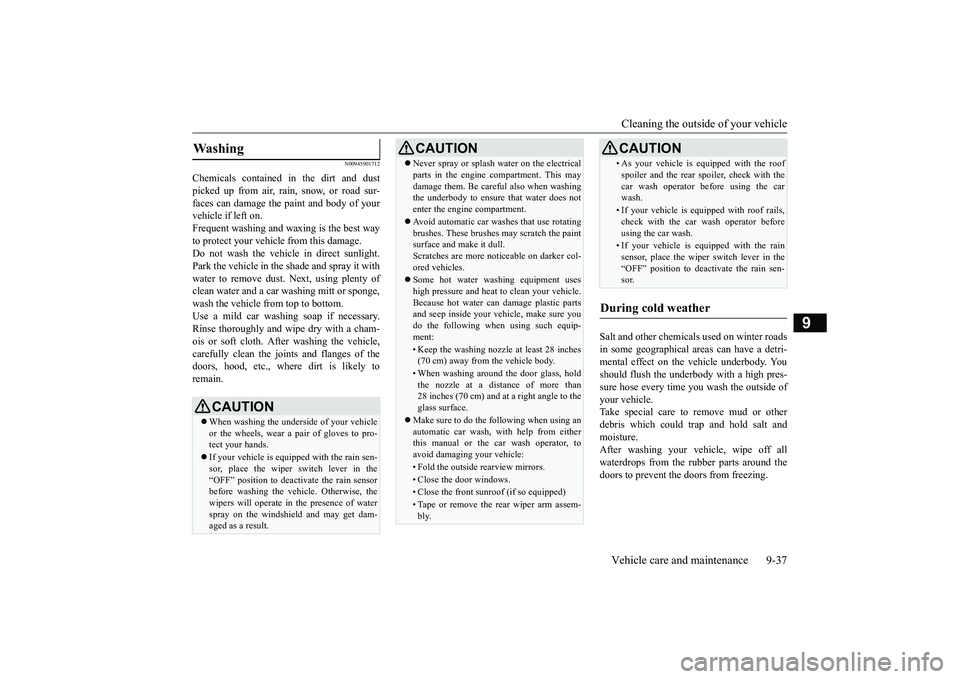
Cleaning the outside of your vehicle Vehicle care and maintenance 9-37
9
N00945901712
Chemicals contained in the dirt and dust picked up from air, rain, snow, or road sur-faces can damage the paint and body of your vehicle if left on. Frequent washing and waxing is the best wayto protect your vehicle from this damage. Do not wash the vehicle in direct sunlight. Park the vehicle in the shade and spray it withwater to remove dust. Next, using plenty ofclean water and a car washing mitt or sponge, wash the vehicle from top to bottom. Use a mild car washing soap if necessary.Rinse thoroughly and wipe dry with a cham- ois or soft cloth. After washing the vehicle, carefully clean the joints and flanges of thedoors, hood, etc., where dirt is likely to remain.
Salt and other chemicals
used on winter roads
in some geographical areas can have a detri- mental effect on the vehicle underbody. You should flush the underbody with a high pres-sure hose every time you wash the outside of your vehicle. Take special care to remove mud or otherdebris which could trap and hold salt and moisture. After washing your vehicle, wipe off allwaterdrops from the rubber parts around the doors to prevent the doors from freezing.
Wa s h i n g
CAUTION When washing the underside of your vehicle or the wheels, wear a pair of gloves to pro-tect your hands. If your vehicle is equipped with the rain sen- sor, place the wiper switch lever in the “OFF” position to deactivate the rain sensorbefore washing the vehicle. Otherwise, the wipers will operate in the presence of water spray on the windshield and may get dam-aged as a result.
Never spray or splash water on the electrical parts in the engine compartment. This may damage them. Be careful also when washing the underbody to ensure that water does not enter the engine compartment. Avoid automatic car washes that use rotating brushes. These brushes may scratch the paintsurface and make it dull. Scratches are more noticeable on darker col- ored vehicles. Some hot water washing equipment uses high pressure and heat
to clean your vehicle.
Because hot water can damage plastic parts and seep inside your vehicle, make sure you do the following when using such equip-ment:• Keep the washing nozzle at least 28 inches(70 cm) away from the vehicle body.• When washing around the door glass, holdthe nozzle at a distance of more than 28 inches (70 cm) and at a right angle to the glass surface.
Make sure to do the following when using an automatic car wash, with help from eitherthis manual or the car wash operator, to avoid damaging your vehicle:• Fold the outside rearview mirrors.• Close the door windows.• Close the front sunroof (if so equipped)• Tape or remove the rear wiper arm assem- bly.CAUTION
• As your vehicle is equipped with the roof spoiler and the rear spoiler, check with the car wash operator before using the car wash.• If your vehicle is equipped with roof rails,check with the car wash operator before using the car wash.• If your vehicle is equipped with the rainsensor, place the wiper switch lever in the“OFF” position to deactivate the rain sen- sor.
During cold weather
CAUTION
BK0252700US.bo
ok 37 ページ 2017年10月4日 水曜日 午後4時54分
Page 396 of 417
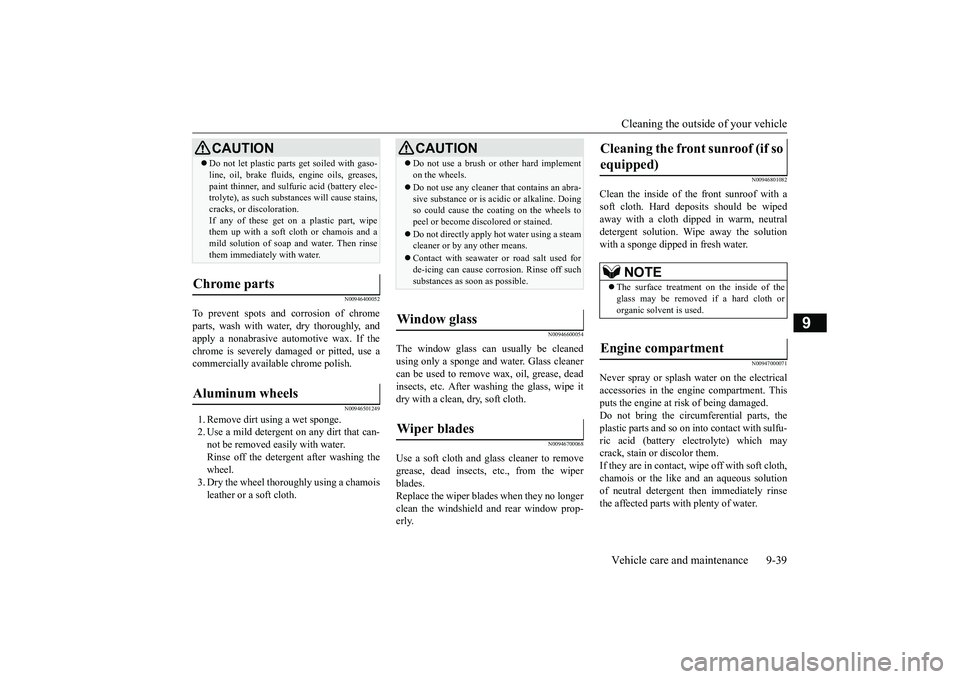
Cleaning the outside of your vehicle Vehicle care and maintenance 9-39
9
N00946400052
To prevent spots and corrosion of chrome parts, wash with water, dry thoroughly, and apply a nonabrasive automotive wax. If thechrome is severely damaged or pitted, use a commercially available chrome polish.
N00946501249
1. Remove dirt using a wet sponge.2. Use a mild detergent on any dirt that can- not be removed easily with water.Rinse off the detergent after washing the wheel. 3. Dry the wheel thoroug
hly using a chamois
leather or a soft cloth.
N00946600054
The window glass can usually be cleanedusing only a sponge and water. Glass cleaner can be used to remove wax, oil, grease, dead insects, etc. After washing the glass, wipe itdry with a clean, dry, soft cloth.
N00946700068
Use a soft cloth and glass cleaner to removegrease, dead insects, etc., from the wiper blades. Replace the wiper blades when they no longerclean the windshield and rear window prop- erly.
N00946801082
Clean the inside of the front sunroof with a soft cloth. Hard deposits should be wiped away with a cloth dipped in warm, neutral detergent solution. Wipe away the solutionwith a sponge dipped in fresh water.
N00947000071
Never spray or splash water on the electricalaccessories in the engine compartment. This puts the engine at risk of being damaged. Do not bring the circumferential parts, theplastic parts and so on into contact with sulfu- ric acid (battery electrolyte) which may crack, stain or discolor them.If they are in contact, wipe off with soft cloth, chamois or the like and an aqueous solution of neutral detergent then immediately rinsethe affected parts with plenty of water.
Do not let plastic parts get soiled with gaso- line, oil, brake fluids
, engine oils, greases,
paint thinner, and sulfuric acid (battery elec- trolyte), as such substances will cause stains, cracks, or discoloration.If any of these get on a plastic part, wipe them up with a soft cloth or chamois and a mild solution of soap and water. Then rinsethem immediately with water.
Chrome parts Aluminum wheels
CAUTION
CAUTION Do not use a brush or other hard implement on the wheels. Do not use any cleaner that contains an abra- sive substance or is acidic or alkaline. Doingso could cause the coating on the wheels to peel or become discolored or stained. Do not directly apply hot water using a steam cleaner or by any other means. Contact with seawater or road salt used for de-icing can cause corrosion. Rinse off such substances as soon as possible.
Window glass Wiper blades
Cleaning the front sunroof (if so equipped)
NOTE
The surface treatment on the inside of the glass may be removed if a hard cloth or organic solvent is used.
Engine compartment
BK0252700US.bo
ok 39 ページ 2017年10月4日 水曜日 午後4時54分
Page 404 of 417
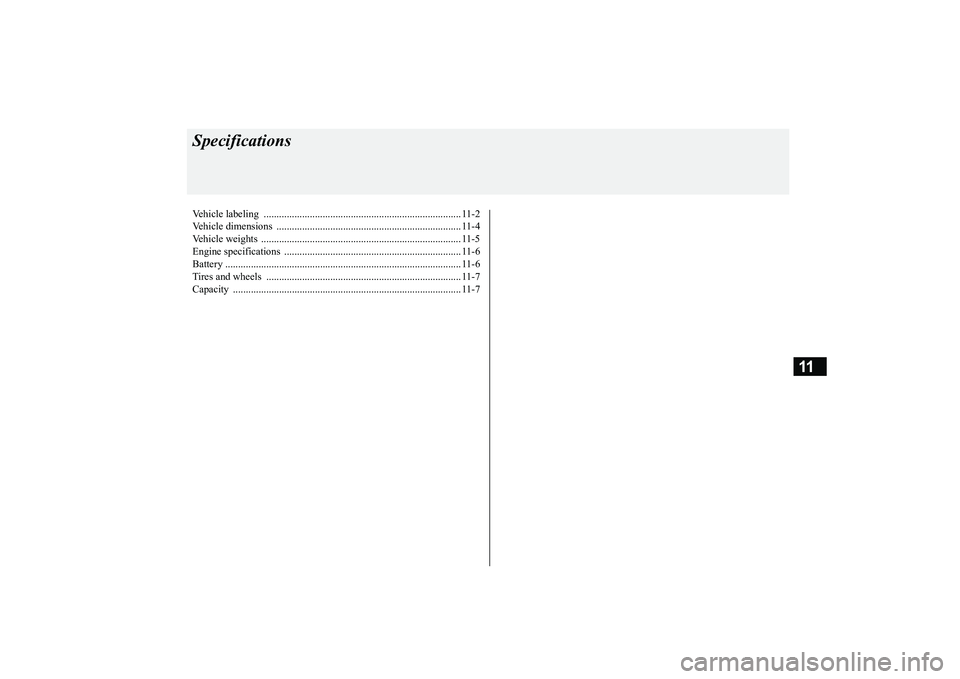
11
SpecificationsVehicle labeling ....
.................................................
........................ 11-2
Vehicle dimensions
................................................
........................ 11-4
Vehicle weights ...............
............................................................... 11-5
Engine specifications
.............................................
........................ 11-6
Battery .......................................
..................................................... 11-6
Tires and wheels .............
............................................................... 11-7
Capacity ....................................
..................................................... 11-7
BK0252700US.bo
ok 1 ページ 2017年10月4日 水曜日 午後4時54分
Page 405 of 417
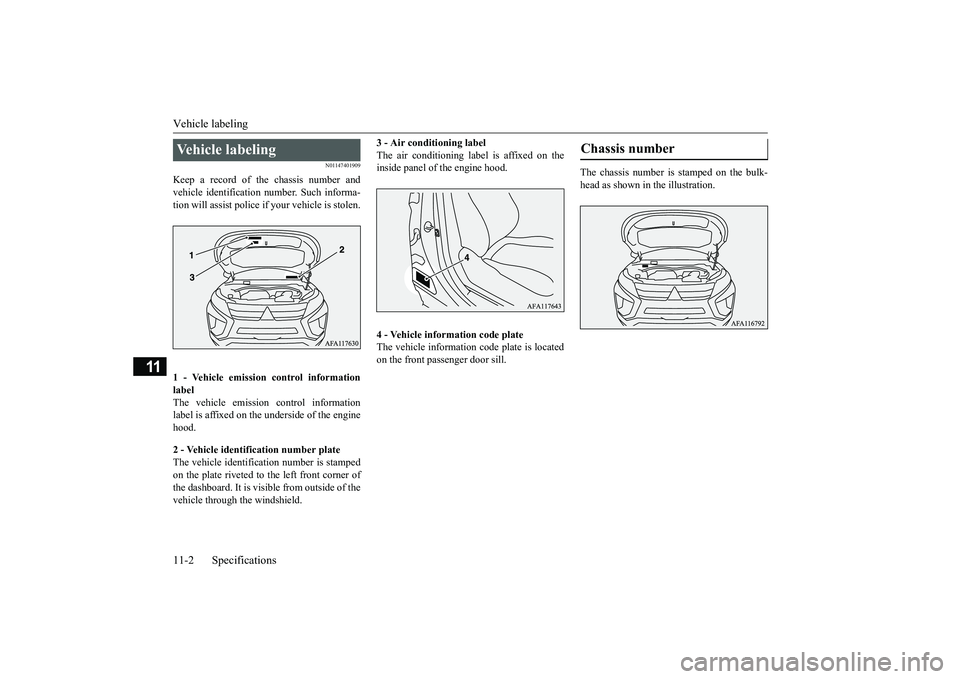
Vehicle labeling 11-2 Specifications
11
N01147401909
Keep a record of the chassis number and vehicle identification number. Such informa-tion will assist police if your vehicle is stolen. 1 - Vehicle emission control information labelThe vehicle emission control informationlabel is affixed on the underside of the engine hood. 2 - Vehicle identification number plate The vehicle identification number is stampedon the plate riveted to the left front corner of the dashboard. It is visible from outside of the vehicle through the windshield.
3 - Air conditioning label The air conditioning label is affixed on the inside panel of the engine hood. 4 - Vehicle information code plate The vehicle information code plate is locatedon the front passenger door sill.
The chassis number is stamped on the bulk- head as shown in the illustration.
Vehicle labeling
Chassis number
BK0252700US.bo
ok 2 ページ 2017年10月4日 水曜日 午後4時54分
Page 406 of 417
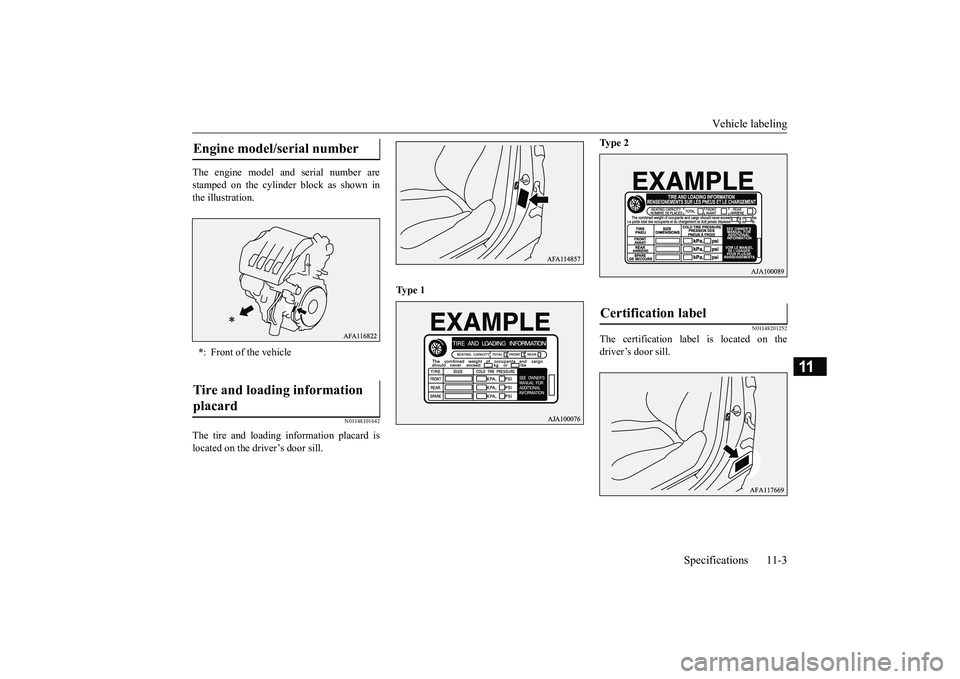
Vehicle labeling
Specifications 11-3
11
The engine model and serial number are stamped on the cylinder block as shown in the illustration.
N01148101642
The tire and loading information placard is located on the driver’s door sill.
Ty p e 1
Ty p e 2
N01148201252
The certification label is located on the driver’s door sill.
Engine model/serial number * : Front of the vehicleTire and loading information placard
Certification label
BK0252700US.bo
ok 3 ページ 2017年10月4日 水曜日 午後4時54分
Page 409 of 417

Engine specifications 11-6 Specifications
11
N01147701609 N01147801365
Battery is a 12 volt type.Engine specifications Engine model
4B40
Engine displacement 91.5 CID (1,500 cm³)No. of cylinders and cylinder arrangement Inline-4Bore
2.95 in (75.0 mm)
Stroke
3.34 in (84.8 mm)
Compression ratio 10.0Thermostat valve opening temperature 179.6 °F (82.0 °C)Spark plugs
NGK SILKR7H8
Spark plug gap .028 to .031 in (0.7 to 0.8 mm)Firing order
1-3-4-2
Battery
75D23L
BK0252700US.bo
ok 6 ページ 2017年10月4日 水曜日 午後4時54分